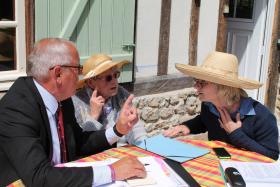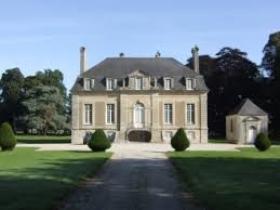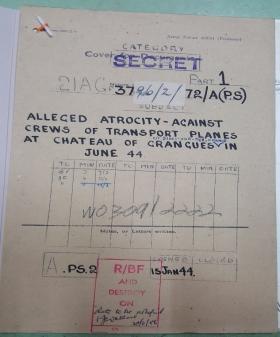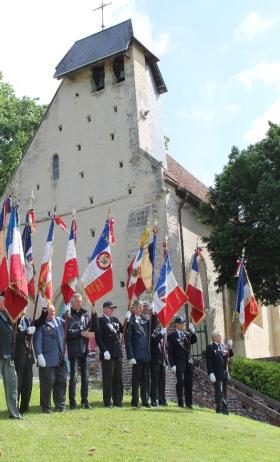OVERVIEW
I have for over twenty years, been investigating, as an ex Detective, the random execution of eight unarmed British soldiers, which took place in the grounds of the Chateau de Grangues situated in the district of Calvados and the French region of Basse- Normandie on the 6th June 1944.
The village of Grangues is located in the township of Dozulé part of the district of Lisieux. The Chateau is located off a road, in the small village or hamlet, opposite the Catholic church of Eglise Notre-Dame, which holds a high point in a valley with high sided rolling hills. The chateau itself is on a ridge on the south facing slope, in its own parkland, surrounded by mature trees.
At the end of May 1944, the German 744th Grenadier Regiment, of the 711th Infantry Division, occupied farm stables and buildings in the grounds of the Chateau, and had dug a defensive position around the Chateau.
The owner of the chateau Le Count de Noblet, Rene, and his family were made to live in the basement of the Chateau. They were joined by 15 others, who either worked in the house, or the grounds, and the nanny to the Counts children Joselyn, Prisca and baby Laurence, one Therese Anne Mallet who was 17 at the time.
The conditions on the family and staff were made uncomfortable by the Germans as they were rarely allowed outside, but when they were they could see the defences and the Germans manning them.
During this time the family were introduced to the Commander of the soldiers, Stabsfeldwebel Hermann VEISELER.
5TH JUNE 1944 - EARLY MORNING
In the early evening of the 5th June, at a transit camp at RAF Harwell, 13 miles south of Oxford, men of 591 Parachute Squadron, Royal Engineers, readied themselves for an operation of massive proportions, where planes and gliders had become zebra like, in black and white identification stripes on the wings and fuselages overnight.
Rehearsals and plans of drop zones were picked through with fine detail, then its men were loaded onto trucks, with their side canvasses tightly closed, and taken to RAF Fairford some 30 miles away, where Stirling aircraft of 620 Squadron were lined up. The aircraft itself was not unfamiliar to this unit, as they had been given familiarisation flights only days before. Many of the soldiers had packed explosives in cycle inner tubes, and wrapped them around their waists, ready for placing on German glider obstructions that needed this type of manipulative or shaped charge.
Their primary task on landing at the drop zone, was to wrap these 5Ib charges around poles that the Germans had placed in all open areas, such as the fields surrounding the village of Ranville, where gliders were to follow a few hours later, with the main task force.
The aircraft were all overloaded, with weapons, tools and specialist equipment needed by these men.
The Squadron took off at 2337hrs precisely on the night before D-DAY in heavy winds. The Squadron crossed the Channel with no incidents occurring, and headed for the designated drop zone with a time forecast on the DZ as 0100hrs on the 6th June D-DAY.
As they got closer to the drop zone, Stirling aircraft call sign EF295-J, was fired upon by German anti-aircraft flak, “a sound like pebbles being thrown at the fuselage, as rounds hit the aircraft”, remarked Lieutenant John Shinner of the Royal Engineers, years later.
He remembers seeing one of his men who had wrapped one of the cycle inner tube charges around his waist, take a direct hit from this flak and burst into flames inside the aircraft, a fire that was impossible to put out, the plane had also had an engine on fire, and lost control fairly quickly after that, with both Pilot and Co-Pilot being killed before the crash. The plane crashed in the grounds of the Chateau with few survivors.
Four men had managed to get to the exit hole in the floor and parachute safely to the ground before the aircraft crashed.
Luckily, Lieutenant Shinner survived the crash, and was led away for interrogation by the Germans who had captured him, as a British officer. All the other ranks who survived were taken to the Chateau.
Soon after, a second Stirling call sign EJ116-U crashed nearby, within the grounds of the Chateau, with no survivors. On this aircraft, were 13 men of the 7th (Light Infantry) Parachute Battalion, and five men of the Special Reconnaissance Squadron, Royal Armoured Corps, one REME soldier, and 6 aircrew. These men who perished in this crash, are all now buried at Ranville Military Cemetery.
The early morning of the 6th of June 1944 D-DAY, at around 0130hrs was to bring more disaster, as four Horsa Gilders call signs, LM494/467/494 and 478, crashed in the grounds of the chateau, these gliders were towed by aircraft of 295 Squadron from RAF Harwell, and released before the other two Stirling’s had crashed. These 295 Squadron aircraft all returned safely to England.
One of the Horsa gliders in the third wave, was piloted by Staff Sergeant Duncan Frank WRIGHT of the Glider Pilot Regiment. His co-pilot was killed in the crash landing in this hilly area around the Chateau, with no flat areas for such gliders to land safely.
He was quickly captured by the Germans and taken directly to the Chateau and secured in the stable block behind the chateau itself, with the other non-commissioned officers and survivors of 591 Parachute Squadron, Royal Engineers, who had been on board Stirling aircraft EF295-J.
Many of the dead on these four gliders were buried in the already dug footings prepared for an extension to the stable block in the grounds of the Chateau. Some were moved to another area later by the Germans, with no reason given as to why they did this, however, all the bodies were later exhumed for a post mortem carried out by a Captain Randall of the Royal Army Medical Corps, and later buried in the Military Cemetery at Ranville with full Military honours.
It was clear from factual documents recovered after the war, and presented to the United Nations War Crime Commission, that injured survivors of the other three gliders were taken to a German hospital at Pont-l’Eveque and then held as Prisoners of War.
FRENCH RED CROSS ASSISTANCE TO THE PRISONERS
Those men who were fit and well, who had survived their respective crashes were all held together in the stables, next to the Chateau.
These men were:
Staff Sergeant 15090818 Duncan Frank WRIGHT aged 25 years, “A” Squadron, 1st Wing, Glider Pilot Regiment.
Corporal 1944972 William Alexander KELLY aged 28 years of 591 (Antrim Territorial Army) Parachute Squadron, Royal Engineers.
Lance Corporal 1878189 Kenneth William BRANSTON aged 20 years of 591 (Antrim Territorial Army) Parachute Squadron, Royal Engineers.
Lance Corporal 882124 Thomas Andrew FRASER aged 24 years of 591 (Antrim Territorial Army) Parachute Squadron, Royal Engineers.
Sapper 14422902 Frank WOLFE aged 22 years of 591 (Antrim Territorial Army) Parachute Squadron, Royal Engineers.
Sapper 14537569 David Henry WHEELER aged 21 years of 591 (Antrim Territorial Army) Parachute Squadron, Royal Engineers.
Sapper 1876309 Peter GUARD aged 20 years of 591 (Antrim Territorial Army) Parachute Squadron, Royal Engineers.
Private/Driver 14283438 George THOMSON aged 22 years of 591 (Antrim Territorial Army) Parachute Squadron, Royal Engineers.
At about 0215hrs on the 6th June 1944, these eight men who had been thoroughly searched and were carrying no weapons whatsoever, were led out of the stable block where they were being held, laid on the ground face down, wearing just their Red Berets, Para smocks/trousers and boots, this was witnessed by the person now known to be a Monsieur Rolland BERTHIER. The MRN initials on statements taken shortly after the incident.
Within minutes all eight soldiers shot by the commander of this German unit, one Stabsfeldwebel Hermann VEISELER, the highest rank below an officer in the German Army, using his issue P38 Walther .38 calibre pistol, and shooting each man above the waist in a vital area, with one exception, where he shot, below the head the enquiry heard in 1945. They all died instantaneously.
VEISELER was confronted by Count Rene Noblet when he had been briefed by BERTHIER, and asked why he had shot these unarmed men contrary to the Geneva Convention, only to be told that they had become restless, and he was concerned that they would escape. Earlier he had said they were shot because they had hidden weapons. In reality, they were searched before being incarcerated in the stable block, so this was untrue. He had in fact mercilessly shot each man. Several days later VEISELER was awarded an Iron Cross for his actions on that night, and informed Count Noblet of this, as if it was a courageous action!! It is more likely, he was trying to show his superiors, that he was an effective soldier, complying with Hitler’s directive dated the 18th of October 1942 that all saboteurs and parachutists were to be shot, regardless of whether they wore a uniform or not.
These men were all cared for before their death by both Count Noblet who was the local representative for the French Red Cross in the Calvados area, and Mayor of Grangues, and his children’s nanny, Therese Anne MALLETT who was also a member of the French Red Cross.
The men were all treated for minor injuries, and the staff, were all forbidden to speak to the men at any time whilst being nursed. No soldier, at that time, had any life threatening injuries at all, when they were seen by both these witnesses’ who were totally reliable.
SUMMARY
The UN War Crimes unit in 1945, took witness statements from those at the Chateau who saw the men alive, and also documented a definitive timeline, leading up to their deaths.
All were credible witnesses, with Count NOBLET being the most crucial, albeit, what was told to him by VEISELER was second hand information and not witnessed personally by any of them, but the credibility of his evidence could be totally relied upon as fact.
The statements were taken down and duly signed with full names as would be expected, but only ever referred to as initials of their names for brevity’s sake at the inquiry, as their full names had been lost in witness papers after the war, and remained, as unnamed until June 2017.
My investigation led me to many parts of Normandy in villages and towns around Grangues, in search of those witnesses who gave that vital evidence against this German soldier.
Hermann VEISELER a soldier described as having Chinese features, with slant eyes, black eye balls, and black hair, who was very tall and of slim build. A soldier who sought favour from all quarters especially his officers, as he was responsible for looking after their prized horses of the Regiment, in the stables at the Chateau. It is recorded that he had seen limited action on the Russian Front.
It was imperative in the time I had left, that I found at least one of those persons, who may still be alive, relating to the initials shown and recorded on the witness statements.
After a week attending many Parachute Regiment ceremonies with veterans around Normandy, finally on the day before I left the region to return home to England, I found who was known only as the “Nanny” now aged 90. Therese Anne MALLETT, who remembered absolutely everything about those she was held with, in the basement of the Chateau 73 years earlier, and all the Germans of note who were stationed there to.
She remembered the night of the shooting and provided me with proven substantive information that confirmed that Stabsfeldwebel Hermann VEISELER, had indeed shot the eight British Paratroopers on the 6th June 1944.
She knew the pistol he used and carried, to which its calibre was confirmed by Captain RANKIN of the Royal Army Medical Corps, when he performed the autopsy’s on the bodies in 1945, finding that each soldier had been shot with a .38 pistol round. Picture showing the type of pistol he used.
It is sad to think, that with the DNA and Forensic expertise available today, if the pistol had been recovered, one could have conclusively matched the pistol to the bullets fired into each of the men from behind, and therefore conclude VEISELER was definitively the executioner.
Much has been written about the 6th of June 1944, and in particular about this particular massacre at the Chateau de Grangues, by family members of the unit whose men were executed.
I would like to show my gratitude and a special thanks to Mrs Lesley Young, the granddaughter of Captain GF Davidson (1912-1945) of the 591 Antrim Parachute Squadron Royal Engineers, for her support in this investigation to finally establish the truth, provided the only surviving witness, namely Therese MALLETT. Albeit it is hearsay evidence, but in my submission, it must be seen as reliable evidence.
Also a special thanks to Andre BOSQUAIN and his family, for their assistance in helping me to track down Therese Anne MALLET, the only living witness at the Chateau, at the crucial time of the massacre in 1944, and their continued hospitality shown to all members of the Airborne Community from both the UK and Canada, each year at the ceremony held at the Church of Eglise Notre Dame, Grangues.
A touching conclusion to my investigation, was to learn from Therese MALLET, of the elderly, and deeply religious Irish nanny to baby Laurence NOBLET, called Mrs GAUTHE, who was also kept in the basement with the family and staff.
She was so outraged at the way the Germans treated the dead soldiers bodies, that she harnessed one of the family donkey’s to a cart, and commandeered a small working party, to ensure all the men had decent burials in the grounds near the stables, to await a proper burial later.
I have now established the names of all the witnesses, from interviewing the surviving witness, and read the official document produced by the investigation team in 1945 under a caveat of Secret. It is a basic document that covers the uncovering of graves in the grounds of the Chateau d’ Grangues and nothing else, the cover of that document is shown.
An interesting fact is, that VEISELER never returned to his home town in Germany, nor did he die during the war, according to accurate German Army records, or come into the hands of the allies as a prisoner.
So one has to conclude from that, he either changed his name, or fled Europe, as the hunt went on for those involved in war crimes, or he indeed was killed, but the circumstances of his death remains unrecorded in official German Army records and statistics.
A memorial to the fifty two men who died at Chateau de Grangue, and in its estate, has been erected at the church, which was unveiled in June 1994.
The locations of the graves, of all of the men that died at this Chateau are recorded in The Parachute Regiment GRAVEWATCH register.
My search continues for Hermann VEISELER if he lives, as he will now be in his nineties. I will not rest until I am provided with irrefutable evidence of his death and place of burial.
If he lives, he will be brought to book for his WAR crimes regardless of his age.
To all those brave Soldiers and Airmen that died that fateful but historic day - Rest in Peace my fellow Airborne Warriors
LEST WE FORGET
UTRINQUE PARATUS
Gil Boyd









Latest Comments
There are currently no comments for this content.
Add Comment
In order to add comments you must be registered with ParaData.
If you are currently a ParaData member please login.
If you are not currently a ParaData member but wish to get involved please register.